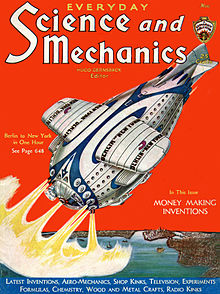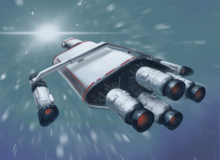Space travel in science fiction
Space travel,[1]: 69 [2]: 209–210 [3]: 511–512 or space flight[2]: 200–201 [4] (less often, starfaring or star voyaging[2]: 217, 220 ) is a classic science-fiction theme that has captivated the public and is almost archetypal for science fiction.[4] Space travel, interplanetary or interstellar, is usually performed in space ships, and spacecraft propulsion in various works ranges from the scientifically plausible to the totally fictitious.[1]: 8, 69–77
While some writers focus on realistic, scientific, and educational aspects of space travel, other writers see this concept as a metaphor for freedom, including "free[ing] mankind from the prison of the solar system".[4] Though the science-fiction rocket has been described as a 20th-century icon,[5]: 744 according to The Encyclopedia of Science Fiction "The means by which space flight has been achieved in sf – its many and various spaceships – have always been of secondary importance to the mythical impact of the theme".[4] Works related to space travel have popularized such concepts as time dilation, space stations, and space colonization.[1]: 69–80 [5]: 743
While generally associated with science fiction, space travel has also occasionally featured in
: 742–743History


A classic, defining trope of the science-fiction genre is that the action takes place in space, either aboard a
In the following centuries, while science fiction addressed many aspects of

From the late 19th and early 20th centuries on, there was a visible distinction between the more "realistic", scientific fiction (which would later evolve into
The successes of 20th-century
On the screen, the 1902 French film I
Means of travel

Generic terms for engines enabling science-fiction
: 8, 69–77The 2007

Many, particularly early, writers of science fiction did not address means of travel in much detail, and many writings of the "proto-SF" era were disadvantaged by their authors' living in a time when knowledge of space was very limited — in fact, many early works did not even consider the concept of
Interstellar travel
Slower than light
With regard to interstellar travel, in which
Faster than light
Some works discuss Einstein's
While usually the means of space travel is just a means to an end, in some works, particularly short stories, it is a central plot device. These works focus on themes such as the mysteries of hyperspace, or the consequences of getting lost after an error or malfunction.[1]: 74–75 [aj]
See also
- Flying saucer
- Human spaceflight
- Space warfare in science fiction
- Space elevator
- Space flight simulation game
- Teleportation
- Unidentified flying object
Notes
- C.S. Lewis' Perelandra (1942); Antoine de Saint-Exupéry's The Little Prince (1943); the 1988 film The Adventures of Baron Munchausen; and Diana Wynne Jones' 2000 novel Year of the Griffin.[5]: 742
- ^ Somnium (1634), The Man in the Moone (1638), Comical History of the States and Empires of the Moon (1657).[6][7][1]: 69 See also A True Story (c. 2nd century).
- ^ with his Skylark series, which debuted in 1928,[4]
- ^ In addition to space opera, this genre includes Robert A. Heinlein's The Man Who Sold the Moon (1950) and James Blish's short story, "Surface Tension" (1952).[4]
- ^ Examples include Stephen Baxter's novel Voyage (1996) and Andy Weir's novel The Martian (2011).[4]
- Phases of Gravity(1989)
- ^ The term "space drive" was used as early as 1932 (John W. Campbell, Invaders from Infinite); and "star drive", in 1948 (Paul Anderson, Genius). "Space drive" is the more generic, whereas "star drive" implies the capability of interstellar travel.[2]: 198, 216
- spindizzy.[1]: 69, 76
- ^ A term invented by Harry Harrison in his Bill, the Galactic Hero (1965)[1]: 108
- ^ A classic idea popularized in the 19th century by Jules Verne's From the Earth to the Moon (1865).[1]: 69
- ^ Dean drive is a real-world, patented invention that promised to generate an anti-gravity force. Before slipping into obscurity, it was briefly promoted by American sci-fi magazine editor John W. Campbell in one of his editorials.[1]: 76 [14]: 181–182
- ^ A popular concept in science fiction, first used in John W. Campbell's Islands of Space (1957), which also introduced the term "space warp".[1]: 77 [15][16]
- Tri-planetary Lensman series.[1]: 75
- ^ Devices that provide steady thrust through a stream of accelerated ions, successfully tested by NASA in the 1990s.[2]: 142
- ^ A scientifically plausible concept of giant scoops that collect interstellar hydrogen to generate fuel during travel. A concept adopted, among others, by Larry Niven in his Known Space series, e.g., World of Ptavvs (1965),[1]: 76
- ^ A term invented by George Griffith in his A Honeymoon in Space (1901).[1]: 69, 108
- ^ An early treatment of this idea is Cordwainer Smith's The Lady Who Sailed the Soul (1960).[1]: 74 This concept was revisited by a number of other writers, such as Arthur C. Clarke in The Wind from the Sun (1972) and Robert L. Forward in Future Magic (1988).[5]: 743
- ^ An anti-gravity engine used in James Blish's Cities in Flight series that began in 1950.[1]: 76–77
- Robert Heinlein's Sky Lift (1953), and that of "torch drive" in Larry Niven's 1976 essay "Words in SF".[2]: 142, 246
- ^ A drive that uses some form of gravity control — which generally implies anti-gravity as well — to propel the ship. Term used by Poul Anderson in his Star Ship (1950).[2]: 81–82, 142
- ^ "Hyperdrive", "overdrive", and "ultradrive" are all defined in Brave New Words as space drives that propel spaceships faster than the speed of light; while "overdrive" and "ultradrive" have no additional characteristic, "hyperdrive" causes spaceships to "enter hyperspace". Brave New Words cites an unspecified story in the January 1949 Startling Stories as the first occurrence of the term "hyperdrive". "Overdrive" is attributed to Murray Leinster's First Contact (1945), and "ultradrive" to Poul Anderson's Tiger by Tail (1958).[2]: 94, 141, 142, 253
- ^ Drive that teleports ships instantaneously from one point to another.[2]: 142 The concept of "jumps" between stars was popularized by Isaac Asimov's Foundation series, which debuted in 1942.[1]: 75 [2]: 142 The term "jump drive" was used in Harry Harrison's Ethical Engineer (1963).[2]: 104
- ^ Classic, proven slower-than-drive drive that generates thrust by ejecting matter in the direction opposite to that of travel — in other words, a rocket. The term was used as early as 1949 in Theodore Sturgeon's Minority Report.[2]: 142, 162
- ^ A fixed teleporter for spaceships. Also known as "jump gate". The term "star gate" was used in Arthur C. Clarke's 2001: A Space Odyssey (1968); "stargate", by Robert Holdstock and Malcolm Edwards in Tour of the Universe (1980), and "jump gate", in the Babylon 5 TV series that debuted in 1993.[2]: 105–106, 142, 217
- Cosmic Stories (May 1941) as using the word "warp" in the context of space travel, though use of this term as a "bend or curvature" in space which facilitates travel can be traced to several works as far back as the mid-1930s, e.g., to Jack Williamson's The Cometeers (1936).[2]: 212, 268
- ^ This theme has occasionally been revisited in modern works, such as Bob Shaw's Land and Overland trilogy that begins with The Ragged Astronauts (1986), set between a pair of planets, Land and Overland, which orbit a common center of gravity, close enough to each other that they share a common atmosphere.[4]
- ^ Verne's idea of using a cannon shot as means of propulsion did not stand the test of time, and the proposed hydraulic shock absorbers and padded walls would not have saved the capsule's crew from death at take-off.[1]: 69
- ^ Tsiolkovsky's Beyond the Planet Earth (1920, but begun in 1896) describes travel to the Moon and the asteroid belt in a rocket spaceship.[1]: 69
- 2001: A Space Odyssey (1968).[3]: 511–512
- : 743
- ^ This concept featured, for example, in A. E. van Vogt's Far Centaurus (1944).[1]: 74
- ^ Bussard ramjets and time dilation feature prominently in Poul Anderson's Tau Zero (1970).[3]: 511–512 [1]: 76 [5]: 743 Time dilation has also been a major plot device in a number of works, for example L. Ron Hubbard's To the Stars (1950), in which the returning astronauts face a society in which centuries have passed.
- ^ Wormhole travel is depicted, for example, in Joe Haldeman's Forever War series that started in 1972.[1]: 77
- ^ Space folding is a term used in, among others, Frank Herbert's Dune (1965).[21]: 214
- ^ The idea appears in Thomas N. Scortia's Sea Change (1956).[1]: 76
References
- ^ ISBN 978-0-517-53174-7.
- ^ ISBN 978-0-19-988552-7.
- ^ ISBN 978-1-78033-704-3.
- ^ a b c d e f g h i j k l m n o p q r s "Themes : Space Flight : SFE : Science Fiction Encyclopedia". www.sf-encyclopedia.com. Retrieved 2021-09-01.
- ^ ISBN 978-0-313-32952-4.
- ^ "Authors : Godwin, Francis : SFE : Science Fiction Encyclopedia". www.sf-encyclopedia.com. Retrieved 2021-09-03.
- ^ "Authors : Cyrano de Bergerac : SFE : Science Fiction Encyclopedia". www.sf-encyclopedia.com. Retrieved 2021-09-03.
- ^ "Themes : Hard SF : SFE : Science Fiction Encyclopedia". www.sf-encyclopedia.com. Retrieved 2021-09-03.
- ^ "Media : Star Trek : SFE : Science Fiction Encyclopedia". www.sf-encyclopedia.com. Retrieved 2021-09-03.
- ISBN 978-1-86189-020-7.
- ISBN 978-0-522-85258-5
- ISBN 978-1-4766-2867-7.
- ^ "Dark Star". Kitbashed. Retrieved 5 January 2021.
- ISBN 978-0-323-14202-1. Retrieved 28 May 2013.
- ^ a b c "Themes : Space Warp : SFE : Science Fiction Encyclopedia". www.sf-encyclopedia.com. Retrieved 2021-09-04.
- ^ a b "Themes : Hyperspace : SFE : Science Fiction Encyclopedia". www.sf-encyclopedia.com. Retrieved 2021-09-03.
- ISBN 978-0-394-53010-9.
- ^ Dwilson, Stephanie Dube (2017-10-09). "'Star Trek: Discovery' New Spore Drive vs. Other Faster-Than-Warp Tech". Heavy.com. Retrieved 2021-09-09.
- ^ "Authors : Tsiolkovsky, Konstantin : SFE : Science Fiction Encyclopedia". www.sf-encyclopedia.com. Retrieved 2021-09-03.
- ISBN 978-84-473-9090-8.
- ^ ISBN 978-1-935251-40-8.
- ^ a b "5 Faster-Than-Light Travel Methods and Their Plausibility". The Escapist. 2014-06-18. Retrieved 2021-09-03.
- ^ "Media : Lost in Space : SFE : Science Fiction Encyclopedia". www.sf-encyclopedia.com. Retrieved 2021-09-08.
Further reading
- Alcubierre, Miguel (2017-06-20). "Astronomy and space on the big screen: How accurately has cinema portrayed space travel and other astrophysical concepts?". Metode Science Studies Journal (7): 211–219. ISSN 2174-9221.
- Fraknoi, Andrew (January 2024). "Science Fiction Stories with Good Astronomy & Physics: A Topical Index" (PDF). Astronomical Society of the Pacific (7.3 ed.). p. 19. Archived (PDF) from the original on 2024-02-10. Retrieved 2024-03-23.
- Kanas, Nick (November 2015). "Ad Astra! Interstellar Travel in Science Fiction". Analog. 135 (11): 4–7.
- May, Andrew (2018). "Journey into Space". Rockets and Ray Guns: The Sci-Fi Science of the Cold War. Science and Fiction. Cham: Springer International Publishing. pp. 41–79. ISBN 978-3-319-89830-8.
- Mollmann, Steven (2011-12-20). "Space Travel in Science Fiction". In Grossman, Leigh (ed.). Sense of Wonder: A Century of Science Fiction. Wildside Press LLC. ISBN 978-1-4344-4035-8.
- Moskowitz, Sam (February 1960). Santesson, Hans Stefan (ed.). "To Mars And Venus in the Gay Nineties". Fantastic Universe. Vol. 12, no. 4. pp. 44–55. ISFDB series #18631.
- Ruehrwein, Donald (May 1, 1979). "A History of Interstellar Space Travel (As Presented in Science Fiction)". Odyssey. 5 (5): 14–17.
- Weitekamp, Margaret A. (2019). ""Ahead, Warp Factor Three, Mr. Sulu": Imagining Interstellar Faster-Than-Light Travel in Space Science Fiction". The Journal of Popular Culture. 52 (5): 1036–1057. S2CID 211643287.
- ISBN 978-1-4766-8659-2.
External links
- "The Science Fiction and Fantasy Research Database. Search Records by Subject: SPACE TRAVEL". sffrd.library.tamu.edu. Retrieved 2021-12-21.
